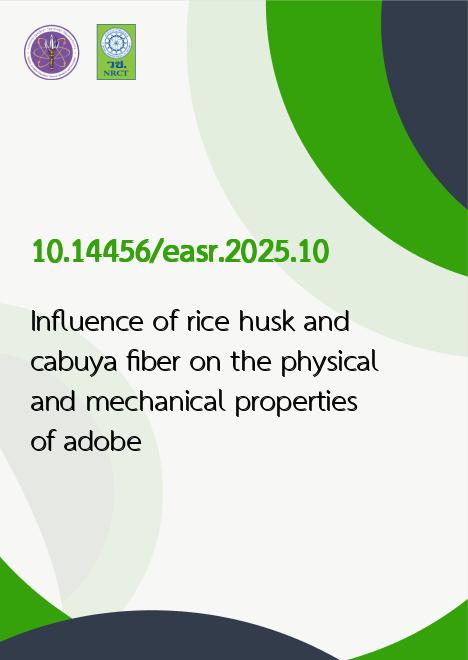
|
Influence of rice husk and cabuya fiber on the physical and mechanical properties of adobe |
|---|---|
| รหัสดีโอไอ | |
| Creator | 1. Danilo Servando Carrasco Pacheco 2. Enrique Mart?n Correa Barboza 3. S?crates Pedro Mu?oz P?rez 4. Juan Mart?n Garc?a Chumacero 5. Elver S?nchez Diaz 6. Carlos Arturo Damiani Lazo 7. Juan De Dios Malpartida Iturregui 8. Nestor Ra?l Salinas Vasquez 9. Ana Paula Bernal Izquierdo |
| Title | Influence of rice husk and cabuya fiber on the physical and mechanical properties of adobe |
| Publisher | Faculty of Engineering, Khon Kaen University |
| Publication Year | 2568 |
| Journal Title | Engineering and Applied Science Research |
| Journal Vol. | 52 |
| Journal No. | 1 |
| Page no. | 112-124 |
| Keyword | Adobe, Rice husk, Cabuya fibers, Civil engineering, Sustainability |
| URL Website | https://ph01.tci-thaijo.org/index.php/easr/index |
| Website title | Engineering and Applied Science Research |
| ISSN | 2539-6161 |
| Abstract | Adobe is one of the most widely used materials in housing construction around the world due to its low cost and ease of preparation. However, one of its main disadvantages is its low compressive and flexural strength. This research aims to study the influence of rice husk (RH) and cabuya fibers (CF) on the physical and mechanical properties of adobe. RH, a by-product available in rice-producing countries, offers environmental and economic benefits, while CF are natural fibers obtained from the leaves of plants of the Agave family. Their incorporation in adobe mixes helps prevent cracks and improves the durability of the final product. The methodology used considered proportions of 0.75%, 5%, 10% and 20% of RH and 0.5%, 1%, 1.5% and 2% of CF per weight of dry soil. The results indicated that the optimum content was 0.75% RH combined with 2% CF, where properties such as absorption and unit weight were reduced, while compressive, flexural, stacking and tensile strength increased by 52.31%, 22.49%, 52.64% and 50.48%, respectively, compared to the standard adobe. Concluding that RH and CF are viable as reinforcements in adobe production, supporting the feasibility of using these combinations as an effective strategy to strengthen adobe structures. |
